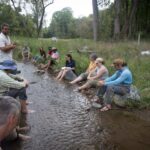by Kate Re, Grant Writer
This autumn, Pearlstone completed a major Waterway Restoration Initiative. We accomplished this with the help of the Chesapeake Bay Trust and the France-Merrick Foundation, who provided generous funding to allow us to finish-up the final piece of this initiative: three beautiful bioretention rain gardens outside of Pearlstone’s guest lodges.
The Waterway Restoration Initiative was designed to dramatically restore and renew Pearlstone’s landscape through ecologically sound water management. The first completed projects included restoring a 1-acre wet meadow and 1,300 feet of restored stream beds. The new rain gardens will interweave with the wet meadow and the stream restoration, cleaning rainwater coming off of Pearlstone’s rooftops and roadways, and slowing it down before it enters meadows, creeks, and stream.
The rain gardens work by capturing stormwater runoff and filtering it through layers of soil and water-loving plants. As the runoff fills the gardens, it slowly percolates into the ground, reducing the risk of flooding and erosion. The water-loving plants consist of native pollinator species; in addition to filtering the water, they also provide habitat and food for local wildlife. The installation of these rain gardens not only helps manage water effectively but also enhances Pearlstone’s aesthetic appeal – in the warmer months, the gardens showcase shades of orange, purple, and white, with floral blooms gently swaying in the breeze. Located at the entrance to the lodges, they serve as living demonstrations of our commitment to environmental education and stewardship, showcasing how ecological design makes human spaces healthier, more balanced, and more inviting.

Completing the Waterway Restoration initiative was a major undertaking, involving eight years of work, $1.5m in funding, and countless stakeholders and partners. The benefits have been profound. Paired with Pearlstone’s regenerative land practices (no-till farming, prescribed burns, invasive species removal, re-seeding native grasses and forbs, and creating a silvopasture orchard), the Waterway Restoration initiative has already made a significant difference in our landscape. Overall moisture and organic content in Pearlstone’s soils has increased dramatically – and both of these are key elements in re-building topsoils in order to combat climate change. According to Carbon Brief: “The world’s soils have lost a total of 133 billion tons of carbon since humans first started farming around 12,000 years ago…The top meter of the world’s soils contains three times as much carbon as the entire atmosphere.” Soil carbon management is increasingly cited as a major negative emissions technology (NET) that could help remove greenhouse gases from the air, and we are dedicated to demonstrating regenerative, climate-friendly soil management at Pearlstone.

As we wrap-up our restoration projects and prepare for winter, we extend heartfelt gratitude to everyone involved in bringing this vision to life. Our goal is to unite the local community in land stewardship as we care for this beautiful planet we all call home, and throughout our restoration work, we’ve collaborated with incredible neighbors (such as the Baltimore American Indian Center, who collaborated with us on the Temakwehane Stream restoration). The successful completion of the rain gardens — and Pearlstone’s ongoing ecological restoration work — is a testament to our team’s dedication, and to the dedication of our community partners. Together, we’re transforming Pearlstone into a sustainable demonstration ground where nature thrives harmoniously with community life.
We invite you to visit the new rain gardens, along with other ecological initiatives. Retreat visitors to Pearlstone enjoy tours and can sign-up for fun educational experiences such as our Campus Quest program (the rain gardens are the first stop on this adventure!). Thank you for being part of this journey toward a more sustainable future at Pearlstone.



